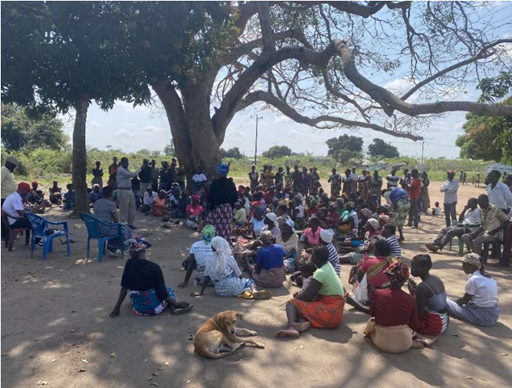As part of a scoping study titled Land Governance for Climate Resilience: A review and case studies from LAND-at-scale projects headed by Richard Sliuzas, Emeritus Professor, University of Twente, CTV explored the links between climate and land governance in the LAND-at-scale project “Scaling Community Legal Literacy, Land Rights Certification and Climate Resilience in Mozambique”. This case study focusses on experiences from the Búzi District, where Cyclone Idai (March 2019) showed the need for proactive interventions in the land sector aimed at preparing districts and local communities to face and plan for severe climatic phenomena and their impacts, but also the challenges at making this link explicit.
Context
Búzi district is in the southern region of Sofala Province, about 180 km from the provincial capital Beira. As one of the province's coastal districts, Búzi forms an integral part of the Sofala Bank, giving it a wealth of commercially valuable fishing resources. The district’s entire coastline is influenced by the warm surface water current of the Mozambique Channel, which leads to higher average air temperatures. Thermal amplitudes in relation to inland temperatures are high, favouring an increase in evaporation and the consequent high humidity, while average annual rainfall is less than 1000mm3. For the past twenty the district has been hit five times by major cyclones (2000, 2008, 2019, 2020 and 2021) that resulted in severe flooding, property damage and loss of life. These events displaced many people from the lower areas along the Búzi river and has led to resettlement on higher ground. In particular after cyclone Idai, Búzi District had to relocate more than half of its population to resettlement areas, far from the risk zones. Nevertheless, several people chose to remain in high-risk areas since, from a legal point of view, there is no specific legislation governing resettlements resulting from disasters, unlike for resettlements resulting from economic investments. Therefore, involving the community is essential in any future planning, especially since climate experts expect cyclones to become more severe and more frequent.
LAND-at-scale in Mozambique
For the LAND-at-scale project in Mozambique, the main objective is to increase the community's legal awareness and strengthen the security of land tenure rights, creating capacity at the local level to implement and leverage the progressive provisions of the Mozambican legal framework. The project is contributing to preparing the community to intervene in an informed way in the land sector and to the delimitation of community and individual land use rights based on bona fide occupation and customary rights, and their integration into the formal land system. CTV is carrying out a large-scale campaign in selected districts in the three regions of Mozambique, with an intervention called Social Preparedness & Legal Literacy. This component builds on ongoing systematic attempts to provide support for the protection of land rights at the local level: the "Community Paralegal Training Program", a program that promotes community legal literacy and institutional capacity building for rights protection and political and economic inclusion by providing knowledge, tools, and data to rural communities. In terms of geographical coverage, the project covers 33 of the 154 districts across all of Mozambique’s provinces.
The need to link land governance and climate resilience
Climate change and its associated meteorological hazards are approached as a cross-cutting issue in the project. The project operates in a broader governance structure of Mozambique, where Local Adaptation Plans (LAP) and District Land Use Plans (DLUP) aim to create land use plans, where DLUPs are more relevant for districts undergoing several transformations in terms of land use as populations are being forced to leave low-lying high-risk lands for higher and safer locations, at least in terms of flooding, such as Búzi. In this context, the project aims to support the design of a DLUP with a view to involving the district's government officials to take ownership of the plan and make better use of it during its 10-year lifespan.
However, the project currently identified an informal relationship between land governance and climate change. Informal because, on the one hand, the legal framework for land, although it mentions climate change, does not determine how land should be managed according to the needs arising from climate change. On the other hand, the legislation that regulates calamities and disasters provides for resettlement as a mitigation measure and gives room for the constitution of land use rights, which is a matter of land governance. It is important to note that in this process the resettled people already have automatic tenure of the land in the resettlement areas and are in the process of obtaining titles for the right to use and enjoy the land. As far as tenure of the land where they once lived is concerned, they retain possession, but they can only farm in those areas, as they cannot live there. Additionally, local people and resettled people have in fact experienced peaceful coexistence so far, also attributed to prior consultation with local leadership.
On the other hand, the complex relationship between land governance action and its effects on climate resilience remains to be confirmed by empirical evidence. Though the project team reports that there are currently good relations between host communities and resettled populations, there is potential for land resource related conflicts to emerge. Additionally, the creation of a District Land Use Plan is also seen to be beneficial for reducing deforestation and reducing host-migrant conflicts, though it is a theoretical view that should be confirmed through empirical investigation of plan implementation and enforcement processes. However, at the moment the project does already disseminate information on climate change in the campaign in the form of environmental education and awareness-raising, keeping it as the most practical approach to climate adaptation and mitigation.
Main take-aways
The link between land governance and climate resilience has not been explicitly made so far in the Búzi case. Additionally, how these links will play out in practice, especially in the development of the DLUPs will remain to be seen. It is important that this becomes a formal relationship that can be shared and widely disseminated. Finally, it is necessary for land governance interventions to anticipate climate change and to design, build and implement land governance mechanisms that will also aid in increasing the climate resilience of citizens, communities, and society in general. Whereas there is a recognition of the importance of land governance to increase climate resilience, in practice, this is difficult to implement as the Mozambique case illustrates.
Want to know more? Get in contact via landatscale@rvo.nl
Or compare the findings with our cases in Colombia, Somalia, and Uganda.
Written by Borges Chivambo & Berta Rafael
Edited by Aoife Ossendorp




